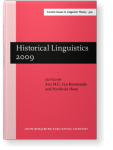The syntactic reconstruction of alignment and word order
The case of Old Japanese
Old Japanese (OJ, 8th century) had split alignment, with nominative-accusative alignment in main clauses and active alignment in nominalized clauses. A number of linguists have proposed nominalization structures as a diachronic source for variation in alignment and word order, particularly for languages that show syncretism of agent and genitive marking, like OJ. This paper applies the so-called ‘nominalist hypothesis’ (cf. Kaufman 2009) to OJ alignment and word order, taking as its main model Gildea’s (1998, 2000) reconstruction of Proto-Carib syntax. The paper shows that the two major OJ clause types fit into a larger cross-linguistic pattern: specifically, the main and nominalized clause types originate as two distinct nominal constructions selected by a copular verb. Main clauses originate as an action nominalization pattern, while the OJ adnominal (and related [+N]) patterns with genitive subjects originate as object nominalizations. These biclausal source structures were reanalyzed prior to OJ as monoclausal, following the process of ‘clausal simplification’ outlined by Harris and Campbell (1995).
Cited by (3)
Cited by three other publications
Aldridge, Edith & Yuko Yanagida
Jessica Coon, Diane Massam & Lisa Demena Travis
2017.
The Oxford Handbook of Ergativity,

This list is based on CrossRef data as of 26 october 2024. Please note that it may not be complete. Sources presented here have been supplied by the respective publishers.
Any errors therein should be reported to them.
